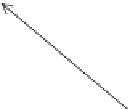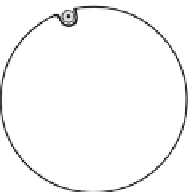Environmental Engineering Reference
In-Depth Information
Stator winding
bs
axis
as'
br
axis
bs
ar'
cs
w
r
br
ar
axis
q
cr
Air gap
as
axis
cr'
br'
ar
bs'
cs'
Rotor winding
as
cs
axis
cr
axis
Figure 3.10
Schematic diagram of a three-phase induction machine (Kundur,
1994)
Rotation
ω
r
Axis of phase
ar
i
ar
i
bs
v
bs
v
ar
v
br
R
s
: Stator resistance
R
r
: Rotor resistance
L
s
: Stator leakage inductance
L
r
: Rotor leakage inductance
L
m
: Magnetising inductance
i
br
θ
v
as
R
r
,
L
r
Axis of phase
as
R
s
,
L
s
i
as
i
cs
v
cr
v
cs
i
cr
L
m
Rotor
Stator
Figure 3.11
Stator and rotor electrical circuit of an induction machine (Kundur,
1994)
electrical circuits. The stator consists of three-phase windings
as
,
bs
and
cs
dis-
tributed 120
apart in space. The rotor circuits have three distributed windings
ar
,
br
and
cr
. The angle
q
is given as the angle by which the axis of the phase
ar
rotor
winding leads the axis of phase
as
stator winding in the direction of rotation, and
w
r
is the rotor angular velocity in electrical rad/s. The angular velocity of the stator
field in electrical rad/s is represented by
w
s
¼
2
p
f
s
.
Voltages are induced in the rotor phases by virtue of their velocity relative to
the stator field, in accordance with Faraday's Law (2.10). The magnitude of the
induced e.m.f. is proportional to the slip. If the rotor is stationary, then the induc-
tion machine may be regarded as a transformer. Suppose the induced rotor voltage



















































































































Search WWH ::

Custom Search